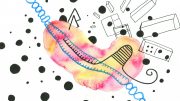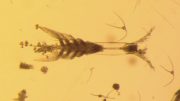The Nobel Prizes in Chemistry, Physics, and Medicine were handed out earlier in October. The prize-winning research included advancements in the small world of microscopy, innovation in sustainable light sources, and how brains makes sense of locations.
Chemistry
The Nobel Prize in Chemistry was awarded to Eric Betzig, Stefan W. Hell, and William E. Moerner for their work on “the development of super-resolved fluorescent microscopy.”
Typical light microscopy has a physical limitation when it comes to the smallest size it can image. The team of chemists developed two separate microscopy techniques that surpass these limitations.
When a fluorescent molecule is exposed to light, it shines light back out of a different colour. Both of these techniques depend on fluorescence.
In 2000, Hell developed a microscopy technique called stimulated emission depletion microscopy. The basis of stimulated emission depletion involves a sort of nano-flashlight. It works by exciting fluorescence molecules, and immediately blocking the bounce-back light from all molecules, except for those in a very tiny spot in the middle, which is recorded.
This flashlight can sweep across a sample to compose a very detailed image. Betzig and Moerner each carried out research developing the other awarded method, single-molecule microscopy, which was first unveiled in 2006. Single-molecular microscopy revolves around the ability to repeatedly excite different fluorescent molecules with weak shots of light, and combining the taken pictures into a composite image.
These techniques allow us to venture into the nanoscale world, and visualize the finest details of living cells.
Physics
The Nobel Prize in Physics was awarded to Isamu Akasaki, Hiroshi Amano, and Shuji Nakamura for their work on “the invention of efficient blue light-emitting diodes which has enabled bright and energy-saving white light resources.”
To produce white light, you have to combine red, green, and blue light through an additive effect. Red and green light emitting diodes, or LEDs, have been around for a while, but the invention of blue LEDs allowed the commercial utilization of white LED light.
Light emitting diodes have the benefit of being very efficient. Older light sources—incandescent and fluorescent lamps, for instance—saw most of the electricity being turned into heat, a rather wasteful use of energy.
Light emitting diodes, on the other hand, do not have this problem; LED lights also have the benefit of “lasting 100 times longer than incandescent bulbs and 10 times longer than fluorescent lamps.” The low energy requirements and long lifespan of LEDs have revolutionized light use in society. Chances are, if you aren’t reading this article on print, you are probably using LED light at this very moment.
Physiology or medicine
The Nobel Prize in Physiology or Medicine was awarded to John O’Keefe, May-Britt Moser, and Edvard Moser for their work on “discoveries of cells that constitute a positioning pattern in the brain.”
There are particular cells in rat brains that compose a sort of internal Google Maps, allowing them to make sense of locations and their position amongst them. The hippocampus is an area of the brain involved in memory, and in 1971, O’Keefe observed that when rats were placed in particular locations, certain nerve cells in this area of the brain were activated.
O’Keefe showed that these “place cells” work together to develop an internal map of the rat’s environment.
In 2005, May-Britt and Edvard discovered a similar process in a nearby area of the rat brain, which interacts with O’Keefe’s hippocampal place cells. These cells form a grid which compose a co-ordinate system in the brain. Recent research has shown that these mechanisms are also found in humans.
It is always humbling to consider how human brains allows us to carry out experiments to understand how the human brain works.
The award recipients and their research helps to make sense of the world around us, as we perceive it, and will allow us to view things in new and sustainable ways. One can argue that, perhaps, scientific research does not have to be rewarded, and that it is intrinsically rewarding.
It would be hard to argue that we would do better without the research that is being acknowledged.




